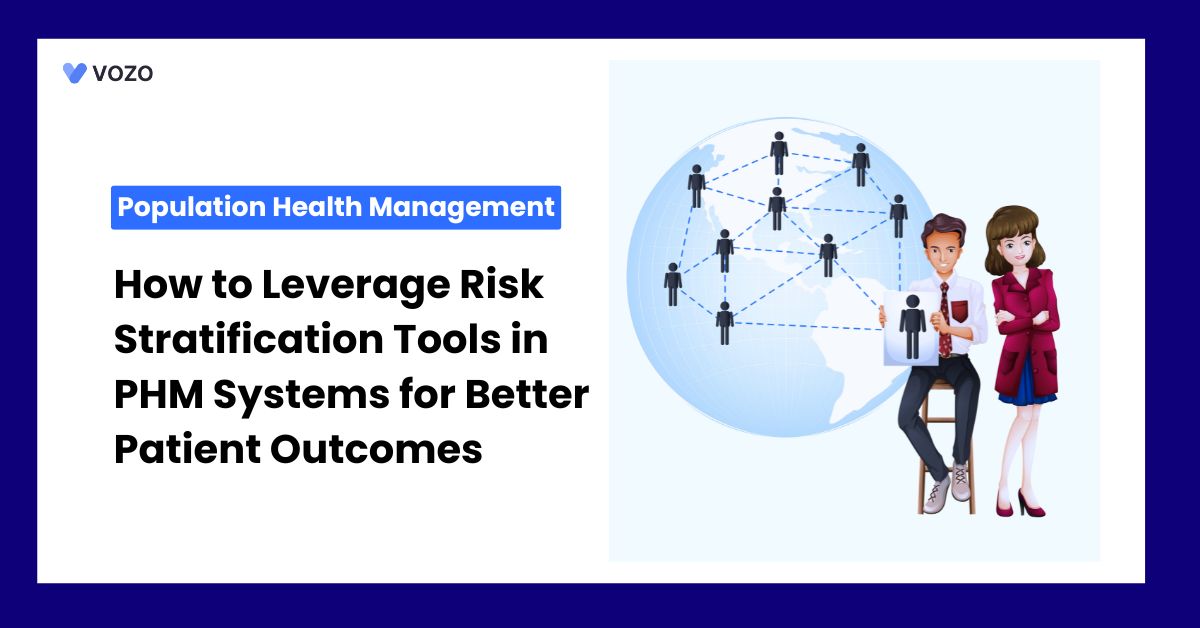How to Leverage Risk Stratification Tools in PHM Systems for Better Patient Outcomes
Healthcare spending in the U.S. reaches $3.8 trillion annually. Chronic diseases account for 90% of this total spending. High-risk patients make up only 5% of all patients. However, they contribute to almost half of healthcare costs. This highlights the need for better patient risk identification.
Risk stratification helps classify patients based on their health risks. Providers use it to focus on patients needing urgent care. It prevents severe conditions and reduces unnecessary hospital visits.
This blog explains how risk stratification benefits healthcare providers, the tools, and the challenges involved in implementation.
What is Risk Stratification?
Risk stratification is a method used to group patients effectively. It categorizes them based on their likelihood of health complications. Providers analyze medical history, lifestyle, and chronic conditions for accuracy. This information helps predict future health risks for each patient. By understanding risk levels, doctors provide the right care faster.
Early detection of high-risk individuals prevents future health emergencies. Healthcare providers save costs by preventing unnecessary hospitalizations. Patients receive personalized care suited to their specific health conditions. Risk stratification ultimately leads to better healthcare efficiency overall.
Why is Risk Stratification Important in Healthcare?
Risk stratification improves healthcare by prioritizing patients like High risk and Low risk. This will enable providers to focus on high-risk patients first. Early interventions reduce the chances of severe health complications. Medical resources are distributed efficiently across different patient groups.
Unnecessary hospital admissions are avoided, lowering overall costs. For example, heart disease risks are detected before symptoms appear. Providers can then provide treatments that prevent major complications. Healthcare has become more preventive instead of reactive over time. This improves both patient well-being and hospital efficiency.
Key Components of Risk Stratification
1. Data Collection
For a proper risk assessment, accurate collection of data is important. Patient details relevant to analysis can be found in the electronic health records. Data sources include patient surveys, lab results, and medical imaging. Lifestyle factors such as smoking or exercise habits are also captured. Collecting data from varied outlets may boost prediction accuracy.
2. Risk Assessment Models
The models classify a patient based on the medical risks. These models analyze the health data of the patients to predict potential future diseases.
One example of a model is the Framingham Risk Score, in particular, heart disease. It calculates the risk for heart disease based on cholesterol, age, and blood pressure. These types of models are beneficial for doctors when it comes to their very well-informed medical decisions.
3. Continuous Monitoring
Patients’ health conditions may change unexpectedly over time. Continuous monitoring will guarantee that the risk assessments are up to date.
The providers change treatment protocols according to new developments in health conditions, thus preventing further worsening conditions and allowing for early intervention. Regular risk classification updates serve to improve accuracy.
Types of Risk Stratification Tools
1. Clinical Prediction Models
Providers can use prediction models to estimate a patient’s future risks. For instance, the Framingham Risk Score for heart disease. This model will consider cholesterol, age, and blood pressure levels. Healthcare providers will use it to assess patient risks and prevent complications.
2. Machine Learning and AI-Based Tools
AI helps process large amounts of patient data for analysis. These tools identify patterns that providers might overlook immediately. AI can predict early serious conditions like heart disease or sepsis.
3. Early Warning Systems
These tools track patient data and detect sudden health declines. Some of the systems will help hospitals spot early warning signs quickly. This ensures that critical patients get timely and effective treatment.
4. Data-Driven Risk Assessment Tools
These tools combine medical and social data for a complete analysis. They help public health experts allocate resources to at-risk populations. This ensures proper healthcare services reach the right communities.
How to Integrate Risk Stratification Tools into PHM Systems
Integrating risk stratification tools will improve patient care and reduce hospital visits. These tools help healthcare providers predict and manage patient health risks. A well-integrated system ensures smooth workflows and better decision-making for providers.
Below is a step-by-step guide to successful implementation.
1. Collect and Standardize Data
Up-to-date information is required for good risk prediction and patient management. Healthcare organizations should be able to gather data from various sources like EHR systems, wearables, insurance claims, and patient self-reports. Because all of these sources provide valuable information for improving health insights.
- Collect data from multiple sources to help improve the accuracy of risk prediction.
- Remove duplicate records to maintain data consistency and avoid errors.
- Check medical codes, such as ICD-10 and CPT, for consistent documentation.
- Include social determinants (income, housing, education) for comprehensive risk assessment.
- HIE networks should facilitate the sharing of real-time data across the healthcare continuum.
After collecting data, organizations ensure consistency and identify and remove duplicate entries. Duplicate records compromise data integrity, leading to inaccurate health assessments of patients.
Therefore, verifying medical codes such as ICD-10 and CPT becomes prudent; this ensures that data is correct and that predictions become more reliable.
2. Ensure System Compatibility and Integration
Risk stratification tools must seamlessly integrate with existing healthcare information systems. Without proper integration, risk scores may not be immediately available. As a provider, you need real-time data access to make informed decisions.
- Use interoperability standards like FHIR, HL7, and DICOM
- Enable two-way data exchange between risk tools and provider dashboards.
- Link risk tools with Clinical Decision Support Systems for better insights.
- Implement cloud-based solutions to improve data accessibility across care settings.
- Ensure security measures to protect patient data and also for complying with regulations.
By using standardized communication protocols, the different systems can interchange data. Among the recognized standards worldwide, the FHIR, HL7, and DICOM stand as the popular choice. These, in effect, ensure the end-to-end exchange of healthcare data within various platforms.
3. Embed Tools into Clinical Workflows
For efficiency, risk stratification tools must integrate seamlessly into workflows. Providers need instant access to risk scores without extra steps. Switching between multiple platforms slows down decision-making and patient care.
- Display risk scores directly within existing EHR systems for easy access.
- Set up automated alerts for sudden changes in patient risk levels.
- Use visual dashboards with color-coded indicators for clear interpretation.
- Automate referrals based on patient risk assessments for timely care.
- Allow customization of risk models to suit specific population needs.
Simple visualizations help healthcare teams quickly interpret and act on data.
Color-coded dashboards or priority-based patient lists improve decision-making efficiency. These features will allow your care teams to focus on high-risk cases.
4. Automate Risk Assessments for Faster Decisions
Manual risk assessments are slow, inefficient, and prone to human error. Automated tools enhance speed, accuracy, and reliability for patient risk predictions.
- Use AI-driven algorithms to analyze patient data efficiently.
- Enable real-time updates to reflect new patient health conditions.
- Implement virtual assistants to notify providers about high-risk patients.
- Connect RPM devices to track patient vitals and predict risks.
- Automate appointment reminders to improve patient engagement and adherence.
Chatbots and virtual assistants notify care teams about urgent patient needs. If a high-risk patient misses an appointment, alerts are sent.
These notifications improve patient engagement and prevent missed treatments.
5. Train Healthcare Teams for Adoption
Even advanced tools require proper training for effective implementation and usage. Providers must understand how to interpret and respond to risk scores.
- Conduct hands-on training to ensure providers use tools effectively.
- Create clinical protocols to standardize responses to risk alerts.
- Design user-friendly interfaces for easy navigation and accessibility.
- Collect provider feedback to refine and improve the system.
- Monitor adoption rates to assess training effectiveness and user experience.
User-friendly interfaces help providers access risk scores without workflow disruptions.
Simple, intuitive designs improve tool adoption and overall usability. The easier the tool, the more likely providers will use it.
Related: The Role of EHRs in Value-Based Care and Population Health Management
Benefits of Risk Stratification for Patient Outcomes
1. Personalized Treatment Plans
Patients receive treatments tailored to their health conditions. Customized care will help to improve recovery rates and enhance overall patient well-being.
2. Early Intervention and Preventive Care
Detecting health risks early prevents serious complications later on. Preventive measures lower emergency hospital visits and expensive treatments.
3. Reduced Hospital Readmissions
Managing high-risk patients lowers unnecessary readmissions significantly. Proper follow-ups prevent conditions from worsening unexpectedly.
4. Optimized Healthcare Resource Allocation
Hospitals direct resources where they are most urgently required. Prioritizing care improves overall efficiency in patient management strategies.
Challenges in Implementing Risk Stratification Tools
1. Data Privacy and Security Concerns
Handling sensitive patient data requires strict security protocols always. So, healthcare practices need to be compliant with healthcare regulations like HIPAA, GDPR, and others.
If your healthcare practice complies with these regulations, you can prevent unauthorized access accessing patient data.
2. Ethical Considerations and Bias in Algorithms
AI systems must avoid bias when assessing patient risk levels. Practices need to ensure that the risk assessment tools do not collide with existing biases. Continuous evaluation ensures fairness in automated decision-making processes.
3. Implementation Costs and System Integration Barriers
Implementing new tools requires infrastructure upgrades and staff training. This process may also be challenging when it comes to integrating it with existing systems.
So, healthcare practices should assess proper investments to ensure smooth transitions without disrupting hospital workflows.
4. Staff Training and Adoption Challenges
Healthcare practices need to educate providers to use the risk stratification tools effectively. Because it is the one that ensures successful implementation. Providing clear instructions and demonstrations to providers will improve adoption rates quickly.
Vozo Cloud EHR for Your Healthcare Practice
If you are searching for the best EHR system for your healthcare practice, Vozo EHR can be your go-to choice. Our comprehensive EHR solution lets you focus more on patient care while carrying all the burdens and simplifying it.
- Vozo Cloud EHR’s cost-effective cloud subscription benefits all levels of practice.
- Our feature-rich EHR helps you rectify mistakes efficiently and speed up the process.
- Vozo Specialty EHR resonates with specialty practice needs and requirements.
- Our expert technical team got you covered 24/7 if any needs arise.
- Our EHR System continues to scale as your healthcare practice grows to improve the user experience.
The Vozo Customized EHR solution benefits your healthcare practice by:
- Streamlining the administrative process
- Improving workflow efficiency
- Reducing proneness to errors
- Manages all the patient’s records in one place
- Offers greater efficiency and cost-savings across the board.
Our specialty-specific tools like scheduling, patient portals, lab integration, cloud hosting, and more meet the specific needs and requirements of your healthcare practice.
“Embrace Vozo EHR to Reduce Your Burdens and Enhance Patient Care”
About the author

With more than 4 years of experience in the dynamic healthcare technology landscape, Sid specializes in crafting compelling content on topics including EHR/EMR, patient portals, healthcare automation, remote patient monitoring, and health information exchange. His expertise lies in translating cutting-edge innovations and intricate topics into engaging narratives that resonate with diverse audiences.













